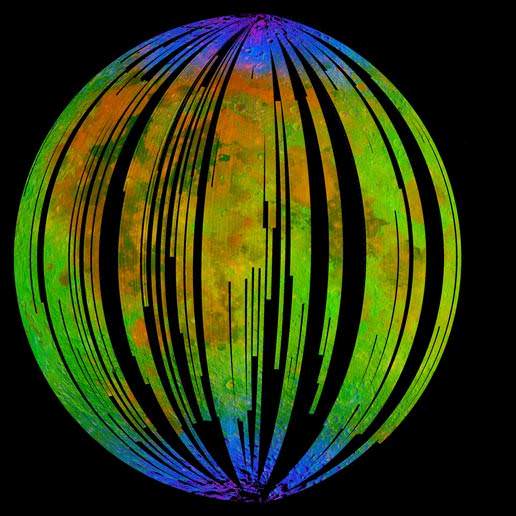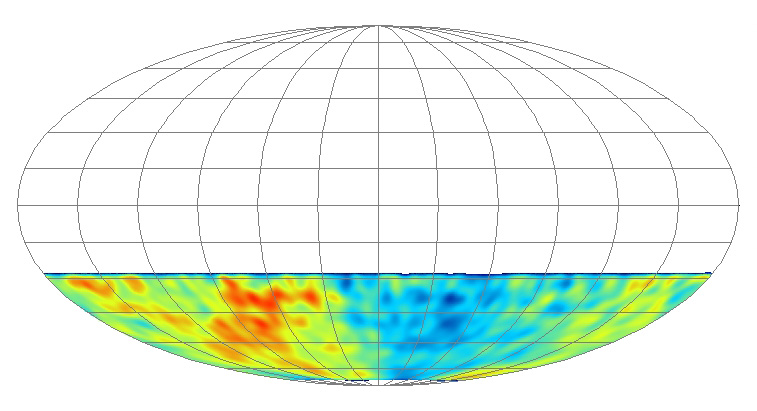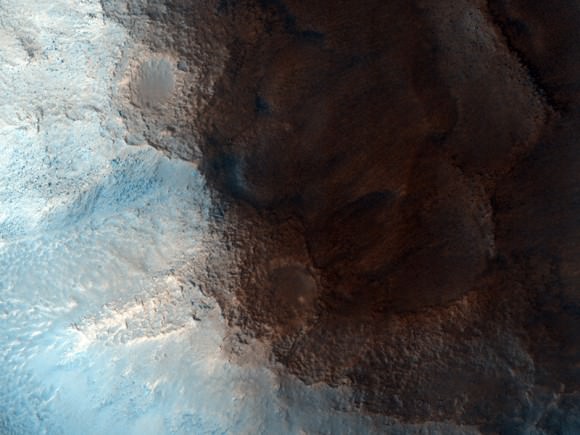A living world, from 370,000 km away | Bad Astronomy
Updated: 2010-07-31 14:30:41
 In all the solar system, in all the galaxy, in all the Universe, there is but one world we know for sure harbors life. Home. The Lunar Reconnaissance Orbiter took this picture in June 2010. From 373,000 km (231,000 miles) away, however, the evidence of life is scant. The image is gray scale, with no blue-green [...]
In all the solar system, in all the galaxy, in all the Universe, there is but one world we know for sure harbors life. Home. The Lunar Reconnaissance Orbiter took this picture in June 2010. From 373,000 km (231,000 miles) away, however, the evidence of life is scant. The image is gray scale, with no blue-green [...]
 : Home Sci-Tech Science and Society Science and Society The Latest Developments in Science and Technology Ned Potter is the science correspondent for ABC's World News with Diane Sawyer . He has reported on such topics as space exploration , the human genome and climate change . Subscribe to this blog's feed RECENT POSTS Mars Rover : Spirit May Never Phone Home Climategate' E-mails : Independent Panel Clears Global Warming Researchers Space Station : Russian Cargo Ship Aborts Docking BP's Next Problem : Tropical Storm . Alex Shaking All Over : Earthquake in Northeast Gulf Oil Spill : Where the Slick May Go Gulf Oil Spill : Brace for Hurricane Season Sunstruck : Shuttle and Space Station , Seen From Earth Gulf of Mexico Spill : Worse Than the Exxon Valdez Gulf Oil Slick : Visible From Space
: Home Sci-Tech Science and Society Science and Society The Latest Developments in Science and Technology Ned Potter is the science correspondent for ABC's World News with Diane Sawyer . He has reported on such topics as space exploration , the human genome and climate change . Subscribe to this blog's feed RECENT POSTS Mars Rover : Spirit May Never Phone Home Climategate' E-mails : Independent Panel Clears Global Warming Researchers Space Station : Russian Cargo Ship Aborts Docking BP's Next Problem : Tropical Storm . Alex Shaking All Over : Earthquake in Northeast Gulf Oil Spill : Where the Slick May Go Gulf Oil Spill : Brace for Hurricane Season Sunstruck : Shuttle and Space Station , Seen From Earth Gulf of Mexico Spill : Worse Than the Exxon Valdez Gulf Oil Slick : Visible From Space • Coyotes are what they eat: Feeding pups soft food changes their bones and muscle structures, making it more difficult for them to chomp on harder stuff later in life. That bites.
• About one-quarter of the food in the U.S. is wasted each year–and 16 percent of our energy goes toward food production. The result? We waste more [...]
• Coyotes are what they eat: Feeding pups soft food changes their bones and muscle structures, making it more difficult for them to chomp on harder stuff later in life. That bites.
• About one-quarter of the food in the U.S. is wasted each year–and 16 percent of our energy goes toward food production. The result? We waste more [...] JPL issued a press release today with an update that mission controllers have still not heard from the hibernating Spirit rover. Even though the rover is experiencing one of Mars' harshest winters since the rovers arrived, the rover team has begun an active "paging" technique called 'sweep and beep' in an effort to communicate with [...]
JPL issued a press release today with an update that mission controllers have still not heard from the hibernating Spirit rover. Even though the rover is experiencing one of Mars' harshest winters since the rovers arrived, the rover team has begun an active "paging" technique called 'sweep and beep' in an effort to communicate with [...] My latest hosted installment of Point of Inquiry just went up. The show is with Francesca Grifo of the Union of Concerned Scientists. Here’s the description:
When President Obama was inaugurated in January of 2009, he pledged to “restore science to its rightful place” in the U.S. government. And true to his word, the president promptly [...]
My latest hosted installment of Point of Inquiry just went up. The show is with Francesca Grifo of the Union of Concerned Scientists. Here’s the description:
When President Obama was inaugurated in January of 2009, he pledged to “restore science to its rightful place” in the U.S. government. And true to his word, the president promptly [...] Still wondering what this image is? Find out the answer to this week's Where In The Universe challenge back on the original post. And check back next week for another test of your visual knowledge of the cosmos! © nancy for Universe Today, 2010. | Permalink | No comment | Add to del.icio.us Post tags: [...]
Still wondering what this image is? Find out the answer to this week's Where In The Universe challenge back on the original post. And check back next week for another test of your visual knowledge of the cosmos! © nancy for Universe Today, 2010. | Permalink | No comment | Add to del.icio.us Post tags: [...] Imagine an infantile version of our 4.6 billion-year-old sun. Now picture a “failed star,” a brown dwarf, about the size of Jupiter, tightly orbiting that 12 million year old stellar baby–at the distance Uranus orbits our sun. Astronomers have just found such a duo: a star about the mass of our sun with an unusually [...]
Imagine an infantile version of our 4.6 billion-year-old sun. Now picture a “failed star,” a brown dwarf, about the size of Jupiter, tightly orbiting that 12 million year old stellar baby–at the distance Uranus orbits our sun. Astronomers have just found such a duo: a star about the mass of our sun with an unusually [...] "Water cycle on the Moon" is a phrase that many people – including lunar scientists – were never expecting to hear. This surprising new finding of ubiquitous water on the surface of the Moon, revealed and confirmed by three different spacecraft last year, has been one of the main topics of recent discussion and study [...]
"Water cycle on the Moon" is a phrase that many people – including lunar scientists – were never expecting to hear. This surprising new finding of ubiquitous water on the surface of the Moon, revealed and confirmed by three different spacecraft last year, has been one of the main topics of recent discussion and study [...] Scientists are eyeing the future of solar technology–specifically, fly eyes. Turns out those bubbly-looking spectators might be just the ticket to more-efficient solar cells, researchers from Penn State University say.
Blowflies have peepers that would help solar panels collect light more efficiently, and creating these fly-eye molds was a feat in itself, according to Discovery News. [...]
Scientists are eyeing the future of solar technology–specifically, fly eyes. Turns out those bubbly-looking spectators might be just the ticket to more-efficient solar cells, researchers from Penn State University say.
Blowflies have peepers that would help solar panels collect light more efficiently, and creating these fly-eye molds was a feat in itself, according to Discovery News. [...] The US House of Representatives are preparing to vote on H.R. 5781, their version of NASA's $19 billion budget authorization for fiscal year 2011, and several groups are calling for a "no" vote, or at the very least, a delay in the vote, currently scheduled for Friday, July 30. The House version would cut much [...]
The US House of Representatives are preparing to vote on H.R. 5781, their version of NASA's $19 billion budget authorization for fiscal year 2011, and several groups are calling for a "no" vote, or at the very least, a delay in the vote, currently scheduled for Friday, July 30. The House version would cut much [...] Researchers camped on the Greenland ice sheet hit bedrock this week after almost three years of drilling, reaching a depth of 8,000 feet. They hope that the ice they’ve uncovered from some 120,000 years ago, might give them a better understanding of what a warmer future might look like, if Greenland has less ice and [...]
Researchers camped on the Greenland ice sheet hit bedrock this week after almost three years of drilling, reaching a depth of 8,000 feet. They hope that the ice they’ve uncovered from some 120,000 years ago, might give them a better understanding of what a warmer future might look like, if Greenland has less ice and [...] Back in 2005, a suite of six instruments on the Cassini spacecraft detected what was thought to be an extensive debris disk around Saturn's moon Rhea, and while there was no visible evidence, researchers thought that perhaps there was a diffuse ring around the moon. This would have been the first ring ever found around [...]
Back in 2005, a suite of six instruments on the Cassini spacecraft detected what was thought to be an extensive debris disk around Saturn's moon Rhea, and while there was no visible evidence, researchers thought that perhaps there was a diffuse ring around the moon. This would have been the first ring ever found around [...] From a University of Wisconsin press release: Though still under construction, the IceCube Neutrino Observatory at the South Pole is already delivering scientific results — including an early finding about a phenomenon the telescope was not even designed to study. IceCube captures signals of notoriously elusive but scientifically fascinating subatomic particles called neutrinos. The telescope [...]
From a University of Wisconsin press release: Though still under construction, the IceCube Neutrino Observatory at the South Pole is already delivering scientific results — including an early finding about a phenomenon the telescope was not even designed to study. IceCube captures signals of notoriously elusive but scientifically fascinating subatomic particles called neutrinos. The telescope [...] They went to investigate solar wind-stirred storms in our planet’s magnetic field, but, after working for three years, two NASA solar-powered probes faced a dark demise, trapped in the Earth’s shadow. NASA researchers now think they can give the twin satellites another shot by altering their courses and sending them instead to study the [...]
They went to investigate solar wind-stirred storms in our planet’s magnetic field, but, after working for three years, two NASA solar-powered probes faced a dark demise, trapped in the Earth’s shadow. NASA researchers now think they can give the twin satellites another shot by altering their courses and sending them instead to study the [...] I know I haven’t been posting much astronomy the past few days — Comic Con, w00tstock, and "Bad Universe" have kept me hopping — so to make up for it a little bit, here’s a lovely image sent back a billion kilometers from Cassini: This is Tethys, an ice moon of Saturn. The angle of Cassini, [...]
I know I haven’t been posting much astronomy the past few days — Comic Con, w00tstock, and "Bad Universe" have kept me hopping — so to make up for it a little bit, here’s a lovely image sent back a billion kilometers from Cassini: This is Tethys, an ice moon of Saturn. The angle of Cassini, [...] Here's a picture you probably won't see in the tabloid racks while waiting in line at the grocery store. This is the famous "Face on Mars," and is the closest image ever of this landform, taken by the best Mars camera ever, HiRISE on the Mars Reconnaissance Orbiter. And it certainly looks like …. the [...]
Here's a picture you probably won't see in the tabloid racks while waiting in line at the grocery store. This is the famous "Face on Mars," and is the closest image ever of this landform, taken by the best Mars camera ever, HiRISE on the Mars Reconnaissance Orbiter. And it certainly looks like …. the [...] David Bradley Science Writer
We’re repeatedly advised to switch off electrical devices, like TVs and DVD players at the mains outlet rather than leaving them in standby mode, to turn to compact fluorescent bulbs and to turn them off when illumination is no longer necessary, to do our laundry at lower temperatures, to run the dishwasher [...]
David Bradley Science Writer
We’re repeatedly advised to switch off electrical devices, like TVs and DVD players at the mains outlet rather than leaving them in standby mode, to turn to compact fluorescent bulbs and to turn them off when illumination is no longer necessary, to do our laundry at lower temperatures, to run the dishwasher [...] David Bradley Science Writer
Scientists hope that Titan, a moon of Saturn, with its nitrogen-rich atmosphere, could act as a model system for terrestrial chemistry before life began on our planet. Now, another step towards that goal has emerged as researchers at the University of Arizona have incorporated atmospheric nitrogen into organic macromolecules under conditions resembling [...]
David Bradley Science Writer
Scientists hope that Titan, a moon of Saturn, with its nitrogen-rich atmosphere, could act as a model system for terrestrial chemistry before life began on our planet. Now, another step towards that goal has emerged as researchers at the University of Arizona have incorporated atmospheric nitrogen into organic macromolecules under conditions resembling [...]